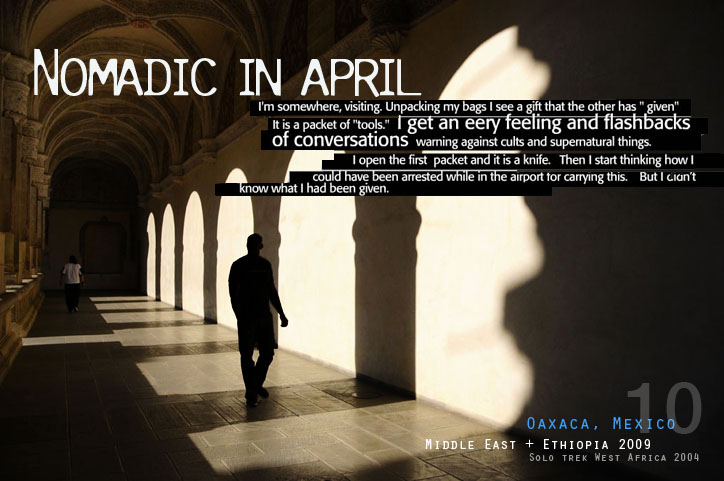First Cocoa Farm
Village near Brenu and Elmina (sometime in week 2. i've lost track of date and time)
My new found friend Japhiya (an African American living in Ghana with his family) agreed to take me to a cocoa farm not too far from where I was staying in Elmina along the coast. We took his apprentice carpenter along as our translator. Although English is the official language, most people speak Twi or Akan and don't understand our "American accents."
The three of us drove off the main road along a dirt packed road. We drove past corn fields, villagers walking by with loads on their heads and piles of harvested produce sitting along the road.
We reached a small village and our interpretor went to find the cocoa farmer. The two came back, the farmer with his machete and we continued down the dirt road. Not too far away we pulled to the side of the road where a dense and dark forest of trees stood to the right and a corn and yam field sat to the left. We got out and followed the cocoa farmer as he quickly went along and cut down ten or so cocoa pods. I tried my best to keep up and take photos and video. The pace was fast and the rain was starting to fall. I notice a pile of discarded and burnt cocoa shells. (After the pods are cut open and the seeds and fruit cut out, the outside is burnt and crushed and used to make other products.)
We hopped back in the tro-tro (like a mini-van) and headed back to the village. I told them I wanted to see how they fermented the beans/seeds. When we arrived at the village, we followed the cocoa farmer through his small village to his family's hut. Outside on a drying bed made from bamboo, a pile of seeds was laying out to dry. They have a strange smell while fermenting, something like vinegar. Japhiya asked if you can eat the fermenting beans. I was concerned about all the flies feeding on the beans. The farmer picked up a bean, peeled off the outside and popped the dark center into his mouth.
It was a very fast visit. The major cocoa harvest starts in late september, but you can find some ripe pods all through out the year.
As Japhiya and I drove back to Elmina, we discussed the challenges of the cocoa farmers and how they struggle to survive. The village we visited was typical for this region. The ground around all the huts is made of pounded dirt. There are a few businesses that sit along the road. Behind the businesses are the family houses or compounds. Most are constructed from hand made cement bricks and have a thatched roof. As we walked through a woman came and asked us for money. Two children stopped and stared at us as if we were aliens. When Japhiya said hello, they picked up their sticks and ran.
We stopped at a station to get petrol and Japhiya suggested that I try a chocolate made in Ghana. It's called Kingsbite. I tried the milk chocolate because it wall they had in the store. It was by far the worst chocolate I've ever put in my mouth! I had been warned, but I couldn't believe it. I had to spit it out. I was chalky, dry, gritty and barely tasted like chocolate. I held a piece in my hand for five minutes. It never melted.
It's really amazing that the world's number two producer of cocoa has the worst chocolate and that it imports decent chocolate from several European countries. Exporting raw goods and importing the same goods as a finished product is one of the many reason why cocoa farmers are so poor. I can't help but think that Ghana can make a much better chocolate for consumption here as well as for export. A business idea waiting to happen . . .
As I travel to the eastern region of Ghana over the next week, I hope to visit several more farms/forests as well as the site of the original cocoa farm in Mampong. Also in the same region is the Cocoa Research Institute of Ghana. Research here is aimed at increasing the amount of seeds in each pod as well as introducing a new species of cocoa trees that are resistant to disease.
I'm still on the look out for a better Ghanaian chocolate.
Friday, August 27, 2004
Subscribe to:
Post Comments (Atom)


No comments:
Post a Comment